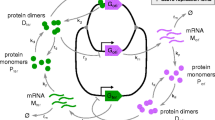Summary
The concentration of plasmid pBR322, of its replication inhibitor, RNAI, and preprimer, RNAII, were observed in E. coli as functions of the bacterial growth rate. At growth rates between 0.6 and 2.5 doubling/h, the copy number (number of plasmids per genome equivalent of chromosomal DNA) decreased from 32 to 15, the number of plasmids per cell increased fro, 39 to 55, and the plasmid concentration decreased from 4.6 to 1.1x1010 plasmids per OD460 unit of cell mass. The concentrations of RNAI and RNAII also decreased with incrasing growth rate, but differently, such that their ratio, RNAI/RNAII, increased. In glycerol minimal medium both RNAI and RNAII had the same halflife, 0.55 min, and were synthesized at a ratio of about 3 RNAI transcripts per every RNAII transcript. These results were interpreted on the basis of the negative control model and suggest that the activities of the RNAI and RNAII promoters, and the efficiency with which RNAI inhibits plasmid replication, are controlled by the growth rate.
Similar content being viewed by others
References
Alwine J, Kemp DJ, Stark GR (1977) Method for detection of specific RNAs in agarose gels by transfer to diazobenzyloxymethyl-paper and hybridization with DNA probes. Proc Natl Acad Sci USA 74:5350–5354
Bachmann BJ (1983) Linkage map of Escherichia coli K-12, Edition 7. Microbiol Rev 47:180–230
Bolivar F, Rodriguez RL, Greene PJ, Betlach MC, Heyneker HL, Boyer HW, Crosa JH, Falkow S (1977) Construction and characterization of new cloning vehicles, II. A multipurpose cloning system. Gene 2:95–113
Churchward G, Bremer H, Young R (1982) Macromolecular composition of bacteria. J Theor Biol 94:651–670
Davison J (1984) Mechanism of control of DNA replication and incompatability in ColE1-type plasmids — a review. Gene 28:1–15
Elble RC, Schneider JC, Tamm J, Muesing MA, Polisky B (1983) Analysis of recessive high copy number mutants of ColE1. UCLA Symposia 10:303–315
Engberg B, Nordstrom K (1975) Replication of the R-factor R1 in Escherichia coli K-12 at different growth rates. J Bacteriol 123:179–186
Helmstetter C (1967) Rate of DNA synthesis during the division cycle of Escherichia coli B/r. J Mol Biol 24:417–427
Klein RD, Selsing E, Wells RD (1980) A rapid microscale technique for isolation of recombinant plasmid DNA suitable for restriction enzyme analysis. Plasmid 3:88–91
Lin-Chao S, Bremer H (1986) Effect of relA function on the replication of plasmid pBR322 in Escherichia coli. Mol Gen Genet 203:150–153
Maniatis T, Fritsch EF, Sambrook J (1982) Molecular cloning. Cold Spring Harbor Laboratory, New York
Miller J (1972) Experiments in molecular genetics. Cold Spring Harbor Laboratory, Cold Spring Harbor, NY, pp 201–205
Muesing M, Tamm J, Shepard HM, Polisky B (1981) A single base-pair alteration is responsible for the DNA overproduction phenotype of a plasmid copy-number mutant. Cell 24:235–242
Peden KWC (1983) Revised sequence of the tetracycline-resistance gene of pBR322. Gene 22:277–280
Pritchard RH (1984) Control of DNA replication in bacteria. In: Nurse P, Streiblova E (eds) The microbial cell cycle. CRC Press, Inc Boca Raton, FL, pp 19–27
Pritchard RH, Grover NB (1981) Control of plasmid replication and its relationship to incompatibility. In: Levy SB, Clowes RC, Koenig EL (eds) Molecular biology, pathogenicity, and ecology of bacterial plasmids. Plenum, New York/London, pp 271–178
Ryals J, Little R, Bremer H (1982) Control of rRNA and tRNA synthesis in Escherichia coli by guanosine tetraphosphate. J Bacteriol 151:1261–1268
Southern EM (1975) Detection of specific sequences among DNA fragments separated by gel electrophoresis. J Mol Biol 98:503–517
Stueber D, Bujard H (1982) Transcription from efficient promoters can interfere with plasmid replication and diminish expression of plasmid specified genes. The EMBO J 1:1399–1404
Tomizawa J (1984) Control of ColE1 plasmid replication: The process of binding of RNAI to the primer transcript. Cell 38:861–870
Tomizawa J (1985) Control of ColE1 plasmid replication: Initial interaction of RNAI and the primer transcript is reversible. Cell 40:527–535
Tomizawa J, Som T (1984) Control of ColE1 plasmid replication: Enhancement of binding of RNAI to the primer transcript by the rom protein. Cell 38:871–878
Twigg AJ, Sherratt D (1980) Trans-complementable copy-number mutants of plasmid ColE1. Nature 283:216–218
Author information
Authors and Affiliations
Additional information
Communicated by R. Devoret
Rights and permissions
About this article
Cite this article
Lin-Chao, S., Bremer, H. Effect of the bacterial growth rate on replication control of plasmid pBR322 in Escherichia coli . Mol Gen Genet 203, 143–149 (1986). https://doi.org/10.1007/BF00330395
Received:
Issue Date:
DOI: https://doi.org/10.1007/BF00330395




